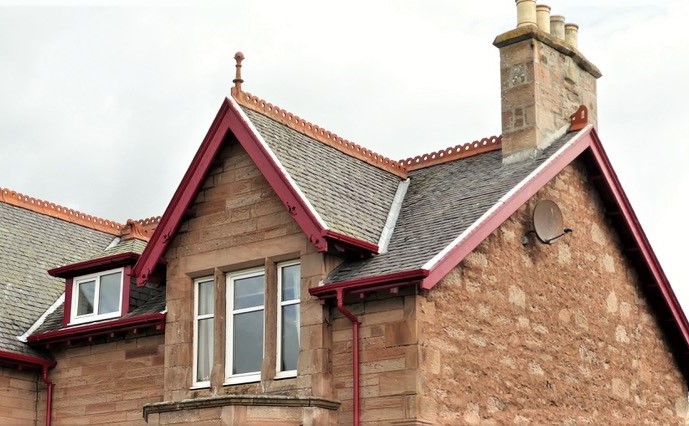Sneck

|
| In this photo, the gable serves as an example of either sneck harl or sneck point. Source: Tim Meek (@TimMeek8), from Twitter (with permission). |
Contents |
[edit] Introduction
Sneck (or sometimes sneckled in the United States) is a type of masonry that uses square stones of various sizes. ‘Snecked masonry’ is describes the finished product, while the term ‘sneck’ refers to the small stones that are incorporated into the filler material. It may also be referred to as snecked rubble, Celtic bond, Scotch bond or ‘travail ecossais’.
NB Sneck is also an expression used in different parts of the UK (particularly Scotland and Ireland) to describe a latch. A sneck is often found on a door or window, but can be used to fasten a gate as well.

|
| In Yorkshire, sneck, snib, latch and catch are all words used for a gate closure device. |
[edit] History - masonry
This technique was most commonly used by masons to construct walls in Scotland and Ireland, sometimes as defensive fortifications during periods of unrest. Sneck masonry was also used in medieval cathedrals, castles and other large structures.
When Scottish and Irish masons migrated to North America in the 1800s, they brought this technique with them. It was frequently used in Central Canada (especially in the province of Ontario) and the East Coast of the United States. Some towns in the state of Vermont (located in New England), have towns with historic and well-preserved houses that have been constructed using this technique.
This is a complex method of masonry that requires a high level of skill, particularly in terms of stone cutting accuracy. The technique arranges larger stones vertically on their edges and then uses small, semi-squared snecks to fill in the areas around the larger stones.Method of sneck construction
There are three types of stone used in snecked masonry.
- Risers (or jumpers), which can be square or semi-square. These should be three times as long as they are tall and should form a rough diamond pattern on the structure.
- Levellers are large stones that are arranged vertically to construct the majority of the structure. They are typically quite long and narrow (sometimes as much as five times as long as they are tall.
- Snecks are the smaller pieces used to compensate for the height differences between risers and levellers. The height of the leveller plus the sneck should be equal to the height of the riser.
This unusual parallel configuration is interrupted by a dramatic break in the horizontal structure created by the levellers. To achieve this, the mason inserts a tall stone (the riser) that touches the course above it. This action strengthens the structure and creates a visually pleasing appearance.
[edit] Related articles on Designing Buildings
- Ashlar.
- Fixing v fastener.
- Harl.
- Masonry.
- Rubble masonry.
- Sneck harl.
- Types of brick bonding.
- Types of lock.
- Unusual construction terms.
[edit] External resources
- City of Glasgow College, Snecked Rubble: Introduction for Stonemasons.
IHBC NewsBlog
Old Sarum fire in listed (& disputed) WW1 Hangar - Wiltshire Council has sought legal advice after fire engulfed a listed First World War hangar that was embroiled in a lengthy planning dispute.
UK Antarctic Heritage Trust launches ‘Virtual Visit’ website area
The Trust calls on people to 'Immerse yourself in our heritage – Making Antarctica Accessible'
Southend Council pledge to force Kursaal owners to maintain building
The Council has pledged to use ‘every tool in the toolbox’ if urgent repairs are not carried out.
HE’s Research Magazine publishes a major study of the heritage of England’s suburbs
The article traces the long evolution of an internal programme to research 200 years of suburban growth
IHBC Context 183 Wellbeing and Heritage published
The issue explores issues at the intersection of heritage and wellbeing.
SAVE celebrates 50 years of campaigning 1975-2025
SAVE Britain’s Heritage has announced events across the country to celebrate bringing new life to remarkable buildings.
IHBC Annual School 2025 - Shrewsbury 12-14 June
Themed Heritage in Context – Value: Plan: Change, join in-person or online.
200th Anniversary Celebration of the Modern Railway Planned
The Stockton & Darlington Railway opened on September 27, 1825.
Competence Framework Launched for Sustainability in the Built Environment
The Construction Industry Council (CIC) and the Edge have jointly published the framework.
Historic England Launches Wellbeing Strategy for Heritage
Whether through visiting, volunteering, learning or creative practice, engaging with heritage can strengthen confidence, resilience, hope and social connections.













